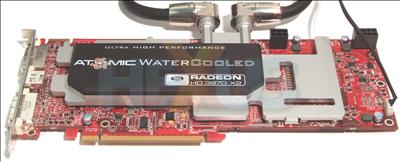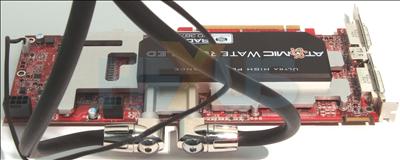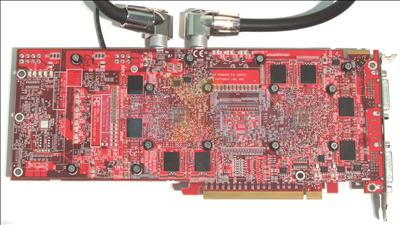A gander
So how do you make what is arguably the fastest graphics card even faster?
Knowing that heat is the enemy when pushing components above their default speeds and with knowledge that electrons pass through better in colder temperatures, Sapphire eschews the reference-like air cooling for its ATOMIC Radeon HD 3870 X2 and uses tried-and-trusted, self-contained water-cooling, which is intrinsically better at drawing the heat away from the GPUs and ferrying it to surrounding areas.
As we near the air-cooled frequency headroom from a particular GPU, heat considerations combine to reduce stability, with the passing of current through the transistors not quite as, well, smooth as at stock speeds. So the quicker you can pull heat away from multi-million-transistor ASICs - or, better still, keep them at negative Celsius levels - the better the frequency scalability.
The PCB for the ATOMIC X2 watercooled is reference; the same as practically every other card currently available. That means it's 266mm x 112mm (w x h); make sure you have enough room in your chassis before contemplating purchase.
The waterblock covers both of the Radeon R680 GPUs and, also, the memory chips on the upper side. The contact and general fitment are good, and the pre-attached block then hooks up to some pre-attached piping that, in turn, leads off to a self-contained radiator and pump assembly - it's all in the box.
It would have been interesting to see an ATOMIC VCT model for the X2 - one that did so well for the single-GPU Radeon HD 3870, however.
A side-on shot of the card shows the low profile of the block that takes up only a single slot and is just a smidgeon taller than the backplate which carries external display and audio connectivity.
Sapphire rushed us one of its very first samples. As such, it was clocked in at a reference-like 825MHz core and 1,800MHz memory. We're still unsure the exact speeds cards will ship at and ran our numbers at the highest speeds currently offered by ATI's OverDrive tool - 878MHz engine and 1,910MHz memory. The all-in-one watercooling solution does go higher, though.
Note, too, that we had to use a hack of AMDGPUClockTool to overclock both GPUs; the current implementation only supports single-GPU overclocking.
Looking at the pipes that ferry the water to-and-fro the twin GPUs, they're designed such that they won't foul any cards placed alongside the ATOMIC X2.
The watercooled card will obviously run at default speeds with no additional cooling aimed at the card, but the best results, when overclocking, necessitate additional card-directed airflow.
Sapphire hasn't bothered to concurrently cool the memory chips on the back of the card, though, and that's a shame, because it effectively limits the memory headroom to that found on fully air-cooled models.
The sleek look shows the profile of the waterblock, right next to the twin auxillary, PCIe-driven power ports.
The card carries both six- and eight-pin PCIe connectors that are fed from your PSU. The eight-pin variety offers up 150W on top of the PCIe x16's 75W and that should be, on paper, enough to power the card. The vagaries of the power plumbing are such that it doesn't work just off the eight-pin alone, however.
The small white header that you see in the above picture hooks up to the all-in-one radiator/pump assembly and regulates the speed of its fans in relation to the GPUs' temperature.
The usual array of outputs that are driven from the primary GPU. There are twin (dual-link) DVI and a seven-pin mini-DIN socket that's useful for exporting video to an eclectic range of displays.















